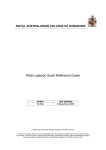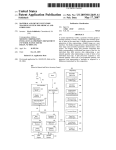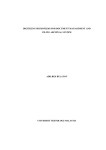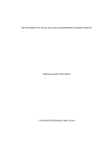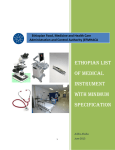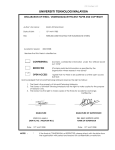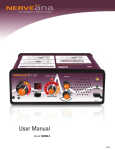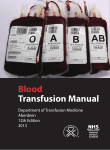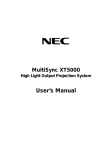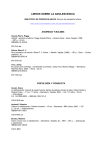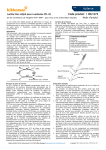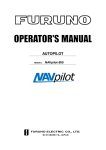Download Untitled - Hospital Sultanah Aminah
Transcript
LABORATORY MANUAL 1 INTRODUCTION The purpose of having a laboratory manual for transfusion service is to improve the overall quality of the blood transfusion service in this hospital. It is meant for all clinicians and other related personnel who directly or indirectly involve with blood transfusion services. All matters pertaining to transfusion practices in this hospital such as blood ordering schedules; procedures for requesting and transfusing blood and blood products, in elective and emergency situations; bedside and clinical transfusion practices, including the handling and reporting of adverse reactions and documentation of clinical outcomes; and information on the use of blood products and blood components, the dosages, transfusion related risks, storage, administration, contraindications will be discussed in this section. This laboratory user manual for Transfusion Services is for use within Hospital Sultanah Aminah Johor Bahru only. This manual is based on Transfusion Practice Guidelines For Clinicians and Laboratory Personnel by National Blood Centre 2003 and are intended to promote better and safer Transfusion Practice in this hospital. 2 LIST OF SERVICES AND LABORATORY TURN AROUND TIME (LTAT) No Tests Schedule LTAT 1. ABO and Rh Grouping Daily 20 minutes 2. Group Screened & Hold Daily 1 – 1 ½ hours 3. Routine Crossmatching Daily 1 ½ - 2 hours 4. Urgent Crossmatch with previous GSH Daily 20 minutes 5. Routine Crossmatch with previous GSH Daily 45 min – 1 hour 6. Emergency Saline Crossmatch (Group Specific Blood) Emergency Uncrossmatched ‘O” Packed Cells Supplying blood products – Platelet concentrates, Fresh Frozen Plasma and Cryoprecipitate. Special blood / product: 9.1 Apheresis Platelet 9.2 Filtered Packed Red Cells 9.3 Irradiated Blood / products Daily 20 – 30 minutes Daily 2 – 5 minutes Daily 20-30 minutes (depends on number of units) By request Depends on stock 1 – 2 hours 1-2 days (From PDN) 7. 8. 9. 10. Neonates and Pediatrics: 10.1 Fresh Whole Blood – exchange transfusion 10.2 Pedibags (Whole Blood / Packed Cells) 10.3 Blood products 45 minutes to 1 hour Daily 45 minutes to 1 hour 20-30 minutes (depends on number of units) TRANSFUSION MEDICINE DEPARTMENT 2010 Page 1 No Tests Schedule 11. Rhesus negative / other rare blood group – elective cases Coomb’s test Antibody identification ABO and Rh Grouping (Antenatal) Cold agglutinin test Transfusion Reaction Work Up By request 12. 13. 14. 15. 16. LTAT Depends on availability 1-3 days Daily 2 hours Daily 1 – 3 days Office hour only 1 – 2 days By Appointment 1 – 3 days Daily 1 – 7 days Note: For any enquiries please consult Medical Officer / Specialist on duty. 3 SERVICE HOURS 24 hours. Note: Blood or component transfusion after office hours is allowed in emergency cases/ life threatening situations only, after proper assessment by consultant / clinician. 4 REQUEST FORMS 4.1 PPDK 5/Pin 1/97 Borang Permohonan Transfusi Darah (Appendix 1), white form in double carbon copy for blood crossmatch and request of blood products. 4.2 The form must be filled completely and written clearly. Prescribing blood and blood products is the responsibility of the doctor managing the patient. However, the doctor is encouraged to consult the doctor in charge of the Blood Bank on the products to give, the quantity, the duration of infusion, the precautions to be taken and any other related matters. a) The request form should be filled in completely and contain relevant patient information, i.e. name, identity card number, sex, reason for transfusion, blood group (if known), previous transfusion reaction and any other relevant information. b) The hospital registration number (R/N) should be used on the request form of patients who, at the time of admission, cannot be reliably identified. This R/N must be ‘unique’ and any investigations for this patient must be identified using this number. When the patient's full and correct details are available the ward personnel should accurately communicate this to the Blood Bank. c) The approximate time when the blood would be required must be stated. Requests for blood to be made available “as soon as possible” should be avoided as this would not assist the blood bank personnel in determining priorities. d) The quantity of the blood/blood component required and the time at which the blood is required should be written on the request form. TRANSFUSION MEDICINE DEPARTMENT 2010 Page 2 5 The timing of blood required for planned procedures should comply with local SOP and the quantity requested for elective surgical patients should follow local surgical blood ordering schedules. Refer MSBOS schedule for Hospital Sultanah Aminah Johor Bahru (Appendix 6). f) The request form should be signed by the requesting doctor and his/her name should be stamped or written in capital letters clearly. 4.3 For other tests, PER PAT 301 (Appendix 2) white form in duplicates. 4.4 Reporting format for ADVERSE TRANSFUSION EVENT form and Laporan Reaksi Kepada Darah Atau Plasma (PPDK 22- Pin. 1/80) for blood / products transfusion reaction (Appendix 3 & 4) SPECIMEN COLLECTION No Test 1 Specimen ABO and Rhesus Grouping, Group Screen and Hold, Crossmatching and Supply of blood products. Blood 2 Antibody Identification Blood 3 Coomb’s test 4 5. Note: 6 e) Volume Adult: 5 mL Paeds: Minimum 2 mls (special requirements, please refer Section 6.3 ) Container EDTA tube Or Plain Tube Minimum 10 mL (more samples may be requested depends on complexity of the case) Plain tube Blood 3 mL 5 mls EDTA tube Plain tube Investigation for transfusion reaction Blood 10 mL Plain tube Cold Agglutinin Test Blood 3 mL Special procedure. By appointment only EDTA tube - Details for blood sample requirement for blood components (such as platelets, fresh frozen plasma and cryoprecipitate), please refer Section 6.4. ORDERING BLOOD FOR TRANSFUSION Most transfusion errors are due to clerical mistakes when samples were taken from the patients or when blood was administered. The practical precautions given in this section are therefore extremely important. Consent is a MUST prior to ALL blood or product transfusion. Transfusion Practice Guidelines For Clinicians And Laboratory Personnel, NBC & KKM, 2nd Edition 2005 6.1 Patient identification and blood sampling for compatibility testing The doctor who is taking the blood sample and who is filling up the compatibility request form must ensure the following: TRANSFUSION MEDICINE DEPARTMENT 2010 Page 3 6.2 6.3 (a) The patient must be correctly identified. The doctor taking the blood sample must read the wristband, if available, and whenever possible, ask the patient to state his/her forename, family name, and date of birth. This information must be checked against the case notes or preprinted patient identification label. (b) Unconscious patients MUST be identified by the information given on the identity band, such as the wristband. (c) An emergency casualty who cannot be reliably identified must be given an identity band with a unique number. This number must be used to identify this patient until full and correct personal details are available. Labeling of sample: (a) The sample must be labeled clearly and accurately at patient's bedside immediately after blood taking. The label should include the patient’s name, hospital registration number or i.c. number and the date and time of collection. (b) The person who took the blood from the patient has to take full responsibility for ensuring that the blood sample is placed in the correctly labeled tube and sign in the request form. (c) The doctor's signature and name on the request form also implies that he has ensured that the sample has been accurately identified. (d) Never label samples from 2 or more patients at the same time. Blood sample requirement for elective surgery or elective transfusion Samples should be sent to the Blood Bank during office hours at least 24 hours before the blood is required. The following is the requirement for blood samples sent in for grouping and compatibility testing: (a) samples from infants less than 4 months of age - infant's blood sample should be accompanied by a sample of the mother's blood - 2.5ml serum/plasma sample from the infant and 5-10ml blood serum/plasma sample from the mother - both samples are to be sent to the GXM Laboratory using one request form (b) samples from patients above 4 months of age - 5 - 10ml serum/plasma sample accompanied by one GXM form - In cases of massive bleeding when many units of blood/ components are required more samples and request forms may be needed. - If the patient requires repeated transfusions during the current admission, a new blood sample is needed for each request. TRANSFUSION MEDICINE DEPARTMENT 2010 Page 4 6.4 7 8 Blood sample requirement for blood components (such as platelets, fresh frozen plasma and cryoprecipitate) (a) If a patient had received a transfusion of blood components within the previous 3 months in the same hospital and if that procedure was without any complications, a new blood sample need NOT accompany requests for more blood components. A copy of the old request form should then be attached to the new request form. (b) In all other circumstances or if the previous request form is not available, a new blood sample should be sent to the laboratory to determine the patient's blood group. RECEIPT OF SPECIMEN AND REQUEST 7.1 All specimens must be sent to the reception counter of Transfusion Medicine Unit. 7.2 Blood bank staff must ensure that the request form is properly filled and the corresponding samples are correctly labeled before accepting the request. REJECTION OF SAMPLES Blood samples sent for compatibility testing should have the suggested minimum requirements. Exceptions are made only in life threatening situation after consulting and obtaining the approval from head of the unit / specialist on duty. The blood samples should be rejected if: (a) the samples are inadequately labeled, insufficient, lysed or in the wrong container; (b) the request form has been inadequately filled such that essential patient information is lacking; and/or (c) there are any discrepancies between the information on the sample label and the request form. For any rejected samples, ward personnel will be notified immediately. Fresh sample with new blood request form will be requested by laboratory technician. The rejected sample and request form will not be returned to the ward to avoid any mistake. TRANSFUSION MEDICINE DEPARTMENT 2010 Page 5 9 GROUP, SCREEN AND HOLD PROTOCOL A Group, Screen and Hold (GSH) protocol consist of an ABO and Rh D group and an antibody screen on the patient’s serum / plasma. Serum / plasma is retained for 48 hours in the blood bank in the event that cross-matching blood is required at a later stage. The aim of this protocol is to control the quality of blood, to maximize the use of blood and to screen for the presence of alloantibodies which may cause significant transfusion reaction or causing incompatibility. In circumstances where the likelihood of blood use is minimal a GSH protocol is recommended in the first instance. If blood is required following a GSH, crossmatched blood should be available for issue within 20 to 30 minutes of the request. A GSH protocol should be used in conjunction with a Maximum Surgical Blood Order Schedule (MSBOS). Current MSBOS is given in Appendix 6. 10 GUIDELINES ON EMERGENCY BLOOD REQUEST In an emergency, blood may be clinically essential prior to the completion of compatibility testing. On these occasions, the requesting clinician must take full responsibility for the use of uncrossmatched blood, which carries a significant risk of severe transfusion reaction and should therefore be restricted to life threatening emergencies. The requesting doctor must state the reasons for such a decision on the request form and sign it. ALL emergency requests should be accompanied by a phone call to the Medical Officer / Specialist on duty to facilitate the process. In a life threatening situations, the following blood categories are available: No Category 1. Emergency Saline Crossmatch (Group Specific Blood) Group specific blood must not be taken on the basis of blood groups done on previous admissions or at other institutions. Availability Procedure Daily (24 hours) 20 – 30 minutes Daily (24 hours) 2-5 minutes 2. A group must be performed on a sample collected during the current admission. Emergency Uncrossmatched ‘O” Packed Cells Generally restricted to occasions when a sample is not immediately available. The Blood Bank must be informed of the emergency by telephone and a pre-transfusion sample and request form must be sent immediately. TRANSFUSION MEDICINE DEPARTMENT 2010 Page 6 10.1 PATIENT IDENTIFICATION i. At all times to include full given name, IC, RN and other necessary information especially blood group. ii. In unconscious patients, where status is not known, it is advisable to use given registered name on arrival to the hospital (A&E Register number e.g. ‘unknown’ ‘RN 62071’). iii. At the blood bank, this name will be registered into our system and will be printed on all the blood stickers. iv. For unknown patient, the identity should be used until patient is stabilized to avoid any confusion during data entry at blood bank or in the ward / OT. 10.2 COMMUNICATION i. The urgency of blood for transfusion is to be indicated clearly on the blood request form (Bekalan diperlukan segera – refer Nota (2) on GXM form). ii. MO/ Specialist on duty MUST be informed regarding the emergency blood request. Note: 1. The Uncrossmatched Emergency O blood is generally restricted to occasions when a sample is not immediately available. Thus, no form or sample is required. 2. The request can only be made after SPECIALIST / CONSULTANT have fully assessed the patient’s condition. 3. Group O Rh POSITIVE packed cells is supplied as Emergency O blood (as the prevalence of RhD negative phenotypes in Malaysia is generally less than 2% of the population.(Guidelines on the Rational Use of Blood and Blood Products, NBC & KKM 2nd edition 2007). 4. Only 2 units of Uncrossmatched Emergency O blood will be supplied, followed as soon as possible by ABO RhD group specific blood according to standard protocol. Please refer to Flow Chart On Uncrossmatched Emergency O Blood. 10.3 SPECIMEN TRANSPORTATION i. The blood sample along with the GXM form is to be brought to the blood bank personally by the doctor involved (HO/MO) or any other authorized staff. ii. On arrival to blood bank, GXM form is to be punched in and ‘Buku penerimaan sample’ is to be filled in immediately. iii. The blood sample and the GXM form are then handed over to the MLT on call. TRANSFUSION MEDICINE DEPARTMENT 2010 Page 7 10.4 BLOOD / PRODUCT TRANSPORTATION i. The same doctor/ authorized staff are to wait in the blood bank until the MLT issues out the blood product needed. ii. Once the blood products are issued out, the doctor/ authorized staff is to check if the blood products supplied are correct and the patient’s particulars printed on the all blood stickers are tally with those on the blood request form. iii. The doctor/ authorized staff are then required to fill in the necessary details into ‘Buku rekod bekalan darah / komponen’. 10.5 RECEPTION OF BLOOD / BLOOD PRODUCTS i. At the ward, the blood products are re-checked at the patient’s bedside before transfusion. ii. It is advisable that in OT, the blood / blood products are to be checked by the anaesthesiologist on duty only. This is to avoid any delay which may occur at the OT reception counter. iii. In cases where the patient’s identity remains unknown, the given registered identity on arrival to the hospital is to be accepted as valid. iv. To avoid any delay in blood supply, it is advisable to use the patient’s initial identity ‘unknown’ until the patient is fully stabilized. v. In cases where the patient’s identity has been discovered, and wants to be used, it is important to state the patient’s initial identity e.g. ‘unknown RN 62071’ on the top of the blood request form (just above the new identity). WARNING: DECISIONS TO TRANSFUSE UNCROSSMATCHED EMERGENCY O BLOOD ONLY AFTER THE SPECIALIST/ CONSULTANT HAVE FULLY ASSESSED THE PATIENT’S CONDITION. It carries a significant risk of severe transfusion reaction and should therefore be RESTRICTED TO LIFE THREATENING EMERGENCIES ONLY. TRANSFUSION MEDICINE DEPARTMENT 2010 Page 8 FLOW CHART ON EMERGENCY SALINE CROSSMATCH (ABO GROUP SPECIFIC) 1. PATIENT IDENTIFICATION KNOWN: FULL NAME/IC/RN UNKNOWN: USE ‘UNKNOWN’ & RN GIVEN IN A&E (TO BE USED UNTIL PATIENT STABILIZED) 2. COMMUNICATION 1. URGENCY OF BLOOD MUST BE STATED CLEARLY ON THE REQUEST FORM. *REFER NOTA (2)” ON THE BLOOD REQUEST FORM 2. FOR ANY DOUBT, PLEASE CALL MO ON CALL / SPECIALIST ON CALL 3. SPECIMEN TRANSPORTATION 1. BLOOD SAMPLE ALONG WITH THE GXM FORM IS TO BE BROUGHT TO THE BLOOD BANK PERSONALLY BY THE DOCTOR: HO/MO/MEDICAL PERSONNEL (‘RUN FOR BLOOD’) 4. BLOOD / PRODUCT TRANSPORTATION 1. SAME DOCTOR MUST WAIT IN THE BLOOD BANK UNTIL MLT ISSUES OUT ALL THE BLOOD / PRODUCTS NEEDED. 2. THE DOCTOR MUST CHECK IF THE BLOOD PRODUCTS SUPPLIED ARE CORRECT & ADEQUATE 3. RECORD 5. RECEPTION OF BLOOD / PRODUCTS 1. RE-CHECKED AT THE PATIENT’S BED SIDE BEFORE TRANSFUSION. 2. IN OT, SHOULD BE CHECKED BY ANAESTHESIOLOGIST TO PREVENT DELAY AT THE RECEPTION COUNTER 3. ONCE PATIENT STABILIZED & IDENTITY HAS BEEN DISCOVERED, PLEASE STATED PATIENT’S INITIAL IDENTITY ON THE TOP OF THE FOLLOWING BLOOD REQUEST FORM END WARNING: ALTHOUGH EMERGENCY ABO SPECIFIC BLOOD HAS BEEN RELEASED FOR USE, FULL GROUP AND CROSSMATCHING PROCEDURES WILL BE UNDERTAKEN SIMULTANEOUSLY IN BLOOD BANK. PROBLEMS ENCOUNTERED DURING THE CROSSMATCHING WILL BE NOTIFIED TO THE CLINICIAN CONCERNED IMMEDIATELY. TRANSFUSION MEDICINE DEPARTMENT 2010 Page 9 FLOW CHART ON UNCROOSMATCHED EMERGENCY O BLOOD UNCROSSMATCHED EMERGENCY O BLOOD HO/MO/ MEDICAL PERSONNEL GO TO BLOOD BANK WITH A EMERGENCY O REQUEST NOTE MLT CUT THE SEGMENT OF THE BLOOD BAG &PROVIDE THE HO / MO WITH EMERGENCY O BLOOD MAXIMUM 2 PINTS ONLY BLOOD BANK WARD KEEP THE EMERGENCY REQUEST NOTE WITH A SEGMENT OF THE EMERGENCY O UNIT SUPPLY TO THE PATIENT – IF FAST IDEALLY PREWARMED THE BLOOD POST TRANSFUSION 1. 2. 3. 1. RECEIVED THE SAMPLE & REQUEST FORM 2. PROCEED WITH COMPATIBILITY TESTING (PATIENT’S SAMPLE VS SEGMENT OF THE EMERGENCY O UNIT) 3. DOCUMENTATION 4. TAKE PATIENT’S SAMPLE FILL UP THE REQUEST FORM COMPLETELY WITH NECESSARY DETAILS WRITE “UNCROSSMATCHED EMERGENCY O” ON THE TOP OF THE FORM SEND SAMPLE & FORM TO BLOOD BANK END WARNING: DECISIONS TO TRANSFUSE UNCROSSMATCHED EMERGENCY O BLOOD ONLY AFTER THE SPECIALIST/ CONSULTANT HAVE FULLY ASSESSED THE PATIENT’S CONDITION. It carries a significant risk of severe transfusion reaction and should therefore be RESTRICTED TO LIFE THREATENING EMERGENCIES ONLY. TRANSFUSION MEDICINE DEPARTMENT 2010 Page 10 11 ISSUE, STORAGE AND TRANSPORT OF BLOOD TO THE WARD Unscreened blood must NOT be used. There must be a system in place to prevent such an occurrence 11.1 Issue of blood and blood component Depending on the local SOP, blood may be released by the transfusion laboratory on request or may be stored in a designated blood refrigerator to be released by the blood bank staff to an authorized staff from the ward when required. Blood Bank staff must ensure that the correct blood and blood component is issued. A checklist (Appendix 7) is provided. 11.2 Collection The person collecting the blood must bring documentary proof of the patient's identity. At the time of collection, blood bank personnel must check that these details match those of the blood unit to be collected. The blood bank personnel must record down the date and time of issue and collection. The record should also contain details of the persons who issued and who collected the blood. Example of checklist format used in Hospital Sultanah Aminah as in Appendix 8. 11.3 Storage and Transport As far as possible blood and blood component should be kept in the blood bank until the blood or blood component is to be transfused. This is especially so for platelets, fresh frozen plasma and cryoprecipitate. If the blood or blood component is not kept at the recommended temperatures it will no longer be suitable for use leading to wastage. This is to be avoided as far as possible. Blood and blood products must be kept at the appropriate temperature given in Appendix 7. Cryoprecipitate and fresh frozen plasma should be kept at between -20°C and -30°C. If a pack is removed from refrigeration and thawed, if infusion did not commence within 30 minutes, the blood will no longer be suitable for use. In this event the pack should be labeled according to the local SOP and returned to the Blood Bank. Red cell products should not be kept more than 4 hours in the wards. WARNING If blood is out of a blood fridge for more than 4 HOURS and not transfused it is no longer suitable for clinical use. Inform Blood Bank, clearly label the blood “Out of Fridge” and return immediately for disposal. TRANSFUSION MEDICINE DEPARTMENT 2010 Page 11 12 GUIDELINES OF ADMINISTERING BLOOD AND BLOOD COMPONENT 12.1 Identification check of intended recipient (Refer Appendix 8 & 9) Blood supplied from the blood bank should have a compatibility label firmly attached. This should carry the following information: (a) (b) (c) (d) (e) (f) Patient's name New identity card number Hospital registration number Patient's blood group Unique pack number ( donation number) Date of issue At the time of transfusion the information on the compatibility label attached to the blood product must be checked carefully with the patient's identification details including the patient's wristband. The blood or blood component should not be transfused if the spelling of the patient’s name or the identification number of the patient does not match exactly with the details given on the blood pack. 12.2 Observe the patient The patient should be carefully observed and monitored for the first 5-10 minutes after the infusion starts. If possible, the first 50 ml of each unit should be given slowly since the first part of each blood unit infused serves as an in vivo compatibility test. The patient's condition including pulse and temperature must then be monitored and recorded periodically until the transfusion is completed. Clinical features of acute transfusion reactions are given in Section 13 and Appendix 5. 12.3 Record keeping Details of all blood components infused (including the donation numbers) must be entered into the patient's case record together with the compatibility report provided by the transfusion laboratory. 12.4 Time limits for infusion There is a risk of bacterial contamination if the blood or red cell packs are kept at room temperatures. For this reason, the infusion must be started within 30 minutes of removing the pack from refrigeration and should normally be completed within 4 hours. The giving set should be changed at least every 12 hours during the blood transfusion. 12.5. Blood administration sets All blood components must be infused through a set containing an integral filter (170 m) to trap large aggregates. TRANSFUSION MEDICINE DEPARTMENT 2010 Page 12 12.6 Microaggregate Filters Filters of 20-40 m pore size can trap small aggregates of leucocytes and platelets which form in all blood stored beyond 5-10 days. There is no indication to use these filters with small volume (2-4 units) transfusion in an adult. Even with very large transfusion volumes there is no proof that microaggregates can cause respiratory problems. Thus the use of these filters is recommended only in patients transfused during cardio-pulmonary bypass and in large volume transfusion of patients with pre-existing lung disease. Blood less than five days old should be used in exchange transfusion of neonates. Under this circumstance, microaggregate removal would not be necessary. 12.7 Blood warmers There is no evidence that warming blood is beneficial to the patient when infusion is slow (1-3 units over several hours). Blood warmers may be used for infusion rates greater than 100 ml/minute as the large volume of cold blood may cause cardiac arrest. Blood warmers must have a visible thermometer and an audible warning device. Red cells and plasma are altered at temperatures over 40C and can cause severe transfusion reactions. Thus, blood must NOT be warmed by putting the pack into hot water or on a radiator or near any uncontrolled heat source. Use of blood warmers should be limited to adults receiving infusions of large blood volumes at rates greater than 50 ml/kg/hr, children receiving volumes greater than 15 ml/kg/hour and for exchange transfusions in infants. If blood is placed in a common blood warmer, before transfusion is commenced, rechecking of the unit for the intended recipient must be done again before infusion of the blood. 12.8 Simultaneous administration of other drugs and fluids Red cell concentrate may be diluted with sodium chloride 0.9% to improve the flow rate. This is most simply done if a Y pattern giving set is used. No other solutions should be added to any blood component. They may contain additives such as calcium (Ringers lactate), which can cause citrated blood to clot. Dextrose solution (5%) can lyse red cells. Drugs should never be added to blood components; if there is an adverse reaction it will be impossible to determine if this is due to the blood or to the medication, which have been added, or to an adverse interaction of the two. 12.9 Used Blood or Remnants of Blood Blood discontinued for any reason must not be used again and must be returned to the Blood Bank as soon as possible. The details of the transfusion and the reasons for discontinuing the transfusion must be stated on the Recipient Card attached to the bag. All discontinued blood must be labeled “USED BLOOD” before it is returned to the Blood Bank. TRANSFUSION MEDICINE DEPARTMENT 2010 Page 13 12.10 Return of Bags On completion of blood transfusion, the ward personnel must ensure that the Recipient Card attached to each bag of blood is filled completely and returned to the Blood Bank (please refer Appendix 10), together with the blood bag containing remnants of the blood transfused. The blood bags must be stored in the refrigerator marked “USED BLOOD BAGS” as early as possible to avoid haemolysis. The return must be documented properly. WARNING Failure to return the recipient card with complete details may give problems to blood bank to document the usage of all blood and blood product. If look back procedure is required either due to seroconverting donor or seroconverting recipient, tracing of patient or donors will be difficult and may cause delay in the investigations. 13 TRANSFUSION REACTIONS All transfusion reactions must be investigated. All personnel involved in ordering and administering transfusions must be able to recognize the signs and symptoms of transfusion reactions and be able to manage them. The causes of transfusion reactions include acute and delayed haemolytic transfusion reactions, bacterial contamination, febrile non-haemolytic transfusion reactions, urticaria and anaphylaxis, transfusion-related acute lung injury, posttransfusion purpura and transfusion associated graft versus host disease. Appendix 5 lists the various types of transfusion reactions and common clinical features. Signs and symptoms that may occur with impending or established transfusion reaction include: (a) (b) (c) (d) (e) (f) (g) (h) (i) (j) (k) (l) (m) (n) Feeling of apprehension Fever Chills Rigors Pain, at infusion site, or in chest, abdomen or flanks Changes in blood pressure, either hypotension or hypertension. Respiratory distress Skin changes Nausea Vomiting Acute onset of sepsis Anaphylaxis Renal shutdown Abnormal bleeding TRANSFUSION MEDICINE DEPARTMENT 2010 Page 14 If an adverse transfusion reaction is suspected, the transfusion should be stopped immediately. The doctor in-charge of the patient must be informed urgently to assess the patient. Further management depends on the type and severity of the reaction. The following steps have to be taken to allow for investigation into the reaction: 14 (a) An ‘immediate’ venous blood sample (at least 8-10 c.c.) should be taken in a plain bottle for antibody identification. (b) Another 2-5 mls venous sample be taken for Full Blood Picture. (c) A urine sample should be collected and inspected as soon as possible before being sent to the laboratory. This specimen may contain haemoglobin and albumin and often contains red cells as well. (d) The remaining blood bag, containing the partially transfused blood, and ALL the blood bags cross-matched for the same patient at the same time of the request should be examined for the presence of free haemoglobin or discolouration before being sent to the laboratory. (e) 24 hours after the detection of the adverse reaction: - another venous blood sample should be taken (again at least 810c.c in a plain bottle) for further tests - another blood sample in EDTA bottle for full blood picture; and - another urine specimen for haemoglobinuria (f) The “Report of Reaction to Blood or Plasma Transfusion” form (refer to Appendix 3) must be completed. (g) The reporting for ‘Adverse Transfusion Event’ should be carried out by the hospital blood banks (refer to Appendix 4) JUDICIOUS USE OF BLOOD AND BLOOD PRODUCTS Clinical judgment about the balance of risks and benefits should be central to any decision to transfuse any blood or blood products. Please refer Appendix 11, Summarized guidelines on prescribing blood or blood products. NOTE: For details, please refer to PUSAT DARAH NEGARA/ KKM GUIDELINES FOR RATIONAL USE OF BLOOD AND BLOOD PRODUCT 2nd edition 2007. TRANSFUSION MEDICINE DEPARTMENT 2010 Page 15 APPENDIX 1 TRANSFUSION MEDICINE DEPARTMENT 2010 Page 16 APPENDIX 2 TRANSFUSION MEDICINE DEPARTMENT 2010 Page 17 APPENDIX 3 LAPURAN REAKSI KEPADA DARAH ATAU PLASMA REPORT OF REACTION TO BLOOD OR PLASMA Hospital …………………………….... Ward/Clinic ……………………… Patient's name …………………………… Reg. Number…………………….. ….Age ………… Sex…….……………..Race….…………………….. Diagnosis………………………………………………………………………………………………………………………. 1. Date and Time transfusion started……………………………………………………………………………………….. 2. Date and Time of onset of reaction……………………………………………………………………………………… 3. Blood/Plasma Serial No………………………………………………………………………………………………….. 4. Volume Blood/Plasma transfused……………………………………………………………………………………….. 5. Temperature: Before transfusion ………………………. After transfusion………………………………………….. 6. Nature of Reaction : Tick off () the positive symptoms/signs. Chills Shock Haematuria Blood Pressure Rigors Jaundice Urticaria Dyspnoea Haemoglobinuria Pain & Location ……………… Elevated ………….. Date noticed ……………………………………………………… 7. Solution use for starting drip:- N.Saline/5% Dextrose/Other………………………………………………………………. 8. History of previous transfusion: Yes/No. Date of last transfusion ……………………………………………………………………………… 9. History of previous reaction: ………………………………………………………………………………………………………………………………….. …………………………………………………………………………………………………………………………………... 10. Additional Information ………………………………………………………………………………………………………... 11. In the case of females: History of pregnancy Yes/No……………………. No. of pregnancies…………………………………………….. History of abortion Yes/No ………………….. No. of abortions……………………………………………….. Tandatangan ……………………………… Tarikh : ………………… Nama………………………………………. 1. When a patients has reaction to blood plasma, inform Doctor i/c IMMEDIATELY 2. Report all reaction. Use the following directions for febrile or suspected haemolytic reaction 3. Preserve the blood bag and giving set with all attached labels, CLOSING IT SECURELY so that cultures can be taken. SEND IMMEDIATELY TO BLOOD BANK. 4. Send 10ml of blood to the Blood Bank for investigation. 5. Send the next urine specimen 20 c.c. to the Pathology Laboratory to examined for haemoglobinuria. 6. Send at least 10 c.c. of clotted blood to the Blood Bank 24 hours after the reaction labelled ‘Post Ttransfusion 2’. These will be used for further compatibility tests and for bilirubin determinations. An additional 2.5 c.c. for Full Blood Picture is also advisable. Similarly a urine specimen should be sent to the Pathology Laboratory. RETURN THIS REPORT AT ONCE TO THE BLOOD BANK TRANSFUSION MEDICINE DEPARTMENT 2010 Page 18 APPENDIX 4 Reporting format for 15 ADVERSE TRANSFUSION EVENT Report ALL adverse events related to transfusion of blood or blood products using this form. Completed form should be sent to your blood bank for compilation. Where appropriate, treatment of reactions and investigations of event should be carried out using existing protocol. Patient’s particulars: Name: ……………………………….. Age: ……………………… Ward:…………………….. I/C no: …………………………………… Race: ……………………. Gender: …………………… Hospital:………………………………………………….. Products implicated in the adverse event: (please tick) Whole blood Packed red cells Plasma (FFP) Platelets Cryoprecipitate Others ………………… Date of transfusion: ………………………….. Time: ……………….. Onset of incident: Pre-transfusion* Immediate (within 24 hours of transfusion) Delayed (after 24 hours of transfusion) Reactions seen / experienced: Fever Nausea Hypertension Chill & rigors Vomiting Hypotension Rash Headache Diarrhoea Itchiness Dyspnoea Chest pain Flushing Bronchospasm Others ……….. Urticaria Pulmonary oedema ……………… Other clinical / laboratory findings: Raised bilirubin / jaundice Deranged liver enzyme Haemoglobinuria Reduced urine output Unexplained fall in haemoglobin None Thrombocytopenia (5-12 days post transfusion) TRANSFUSION MEDICINE DEPARTMENT 2010 Page 19 Type of adverse event: Incorrect transfusion of blood product Acute transfusion reaction Hemolytic Non-haemolytic / anaphylaxis Delayed haemolytic transfusion reaction Bacterial contamination Suspected organism:………………………………………….. Post-transfusion viral infection Suspected virus:…………………………………………….…. Post transfusion purpura Transfusion associated graft versus host disease (TA-GVHD) Transfusion Related Acute Lung Injury (TRALI) Near misses* Specify: …………………………………………..…. *Near misses / pre-transfusion incident – errors detected before transfusion took place eg. wrong sample, wrong label, wrong blood issued, clerical errors. Reported by: Name: …………………………………….. Designation: ………………………………. Hospital: ………………………………….. Tel no: …………………………………….. Date: ……………………………………… TRANSFUSION MEDICINE DEPARTMENT 2010 Page 20 APPENDIX 5 Main clinical features of adverse events Adverse Events 1 Incorrect blood or component transfused a) ABO compatible b) ABO incompatible 2 Acute transfusion reaction a) Haemolytic Common clinical features Maybe none or as in acute haemolytic transfusion reaction if patient has antibodies against transfused red cells Maybe none or major collapse as in acute haemolytic transfusion reaction Fever, chills, dyspnoea, chest pain, hypotension, oliguria, DIC b) Non-haemolytic Chills, itchiness, rash, urticaria, flushing c) Anaphylaxis Urticaria, dyspnoea, hypotension, bronchospasm 3 Delayed haemolytic transfusion reaction Unexplained fall in Hb, jaundice, dark coloured urine 4 Bacterial contamination Fever, rapid onset of shock 5 Post-transfusion viral infection May take weeks or months to manifest, depending on the virus Jaundice, malaise, rash, fever 6 Post-transfusion purpura (PTP) Purpura, bleeding, thrombocytopenia 5-12 days post transfusion 7 Transfusion Associated Graft Versus Host Disease (TA-GVHD) Fever, rash, raised liver enzymes, diarrhoea, nausea, vomiting, pancytopenia (1-6 weeks post transfusion) 8 Transfusion Related Acute Lung Injury (TRALI) Acute respiratory distress (non-cardiogenic), chill, fever, cyanosis, hypoxia, hypotension, bilateral pulmonary infiltrate PLEASE SEND REPORT TO National Coordinator on Surveilance of Adverse events in Transfusion. National Blood Center, Kuala Lumpur, Jalan Tun Razak, 50400, Kuala Lumpur Telephone No: 03- 26955555/26955554 Confidential Fax No: 26925826 TRANSFUSION MEDICINE DEPARTMENT 2010 Page 21 APPENDIX 6 MAXIMUM SURGICAL BLOOD ORDER SCHEDULE (MSBOS) FOR HOSPITAL SULTANAH AMINAH GENERAL SURGERY GSH Cholecytectomy Colectomy Hemicolectomy Small bowel resection Hiatus hemia repair abdominal Inguinal hernia repair Laparotomy Thyroidectomy Parathytroidectomy Varicose veins Vagotomy Adrenalectomy Mastectomy Colostomy closure GXM 4 pints Abdominal-perineal resection Oesophagectomy Pancreatectomy Portocaval shunt Whipple’s procedure 2 pints Gastrectomy Hiatus hemia repairtransthoracic Laparatomy - Perforated viscus Splenectomy Intra-abdominal injury 3 pints Hepatectomy OBSTETRIC & GYNAECOLOGY GSH Hysterectomy - abdominal, vaginal Ovarian Cystectomy Termination, D & C Vaginal Repair All LSCS except bleeding Diagnostic laparoscopy for ectopic pregnancy High risk patients in labour GXM 2 pints Hysterectomy - Wertheim Myomectomy Vulvectomy Placenta abruptio LSCS KIV TAH Bleeding placenta previa Severe endometriosis for TAH Molar pregnancy Ectopic pregnancy for laparatomy CARDIOTHORACIC GSH Pleurectomy Thymectomy Open lung biopsy Tracheostomy Removal of sternal wire Pacemaker insertion Cardiac catheterisation Coronary angiogram GXM 5 pints Redo – CABG Redo – valve surgery BENTALL surgery Aortic trauma 3 pints Offpump CABG Mitral valve replacement Aortic valve replacement ASD closure VSD closure Excision of atrial myxoma Pnemonectomy 4 pints Primary CABG Double valve replacement Cardiac trauma Thoracic trauma Emergency chest re-open 2 pints PDA ligation Lobectomy Excision of mediastinal mass Re-thoracotomy Pericardial effusion drainage Sternal rewiring Deep sternal wound debridement Hospital Transfusion Committee HSAJB (revised March 2008) Note: For any enquiries, please consult Head of Unit / Medical Officer on duty. TRANSFUSION MEDICINE DEPARTMENT 2010 Page 22 ORTHOPAEDIC GSH Trauma Fixation of upper limb fractures with/without tourniquet Fixation of lower limb fractures with tourniquet Fixation of hip screws and DHS Closed interlocking nail os femur Joint surgeries Arthroscopic surgeries Shoulder surgeries except total shoulder replacement and brachial plexus exploration Hemiarthroplasty of hip Putti-Platt shoulder repair Paediatric orthopedics All surgeries with tourniquet Open capsulorrhaphy of DDH Spine One level laminectomy One level posterior fusion with instrumentation without interbody fusion Miscellaneous Elective AKA & BKA Elective upper limb amputation All hand surgeries with tourniquet GXM 2 pints Femoral osteotomy Total knee replacement Total shoulder replacement 3 pints Total hip replacement 4 pints Harrington rods UROLOGY GSH Percutaneous nephrolithotomy (PCNL) Pyelolithotomy - simple Renal transplant TUR prostate Ureterolithotomy GXM 6 pints Cystectomy Prostatectomy 4 pints Nephrectomy 2 pints Pyelolithotomy- complicated or large calculus Retropubic prostatectomy Urethroplasty NEUROSURGICAL GXM 4 pints Tumour debulking/excision Aneurysmal clipping Craniotomy for trauma cases 2 pints Laminectomy Cervical fusion Paediatric cases – according to patient weight 1 pint VP-shunt Extraventricular drainage (EVD) Burrhole & drainage Stereotactic biopsy of brain tumour EAR, NOSE & THROAT GSH Rhinoplasty – augmentation/reduction Parotidectomy Tonsilectomy Adenoidectomy Adenotonsilectomy Drainage of retropharyneal & parapharyngeal abscess MISCELLANEOUS GSH Liver, renal biopsy Hospital Transfusion Committee HSAJB (revised March2008) Note: For any enquiries, please consult Head of Unit / Medical Officer on duty. TRANSFUSION MEDICINE DEPARTMENT 2010 Page 23 APPENDIX 7 INSTRUCTIONS ON PROPER HANDLING OF BLOOD AND BLOOD PRODUCTS IN THE WARD Whole blood / RBC. Supply - After Crossmatch Platelet Conc. Cryo/LP/FFP - Group Specific/ Compatible - No Crossmatching Required - Group Specific - No Crossmatching Required - Should be thawed REQUEST ONLY WHEN REQUIRED Collection - Blood Box WITH Ice - Blood Box WITHOUT Ice Blood Box WITH Ice Use - As Soon As Possible (After Reaching The Ward) - Transfuse Immediately - Transfuse Immediately +2°C to +6°C Room Temperature + 20°C to + 24°C on agitator SHOULD NOT BE STORED OR KEPT IN THE WARDS Storage DO NOT FRIDGE Return - Return Immediately If Not Used STORE IN - Return Immediately If Not Used - Return Immediately If Not Used Fill Up Blood Comp. Tag (PPDK 1) And Return Together With Empty Bag To UTP HSAJB As Soon As Possible Fill Up Blood Comp. Tag (PPDK 1) And Return Together With Empty Bag to UTP HSAJB As Soon As Possible SHOULD NOT BE KEPT > 4 HOURS IN THE WARDS After Used Fill Up Blood Tag (PPDK 1) And Return Together With Empty Bag to UTP HSAJB As Soon As Possible TRANSFUSION MEDICINE DEPARTMENT 2010 Page 24 APPENDIX 8 CHECKLIST FOR THE ISSUE OF BLOOD OR PLASMA BEFORE YOU ISSUE BLOOD OR PLASMA 1. Check that the person collecting the blood or plasma has brought documentation to identify the patient. 2. Check the patient’s: Name Hospital reference number Ward Blood group With The blood request form The compatibility label The compatibility register 3. Check that all other tests, including anti-HIV, hepatitis B and syphilis, have been performed and are negative 4. Confirm that the blood or plasma is compatible by checking the blood group on: The blood request form The compatibility label The compatibility registers. 5. Check the expiry date of the blood or plasma. 6. Inspect the blood or plasma for any signs of deterioration. 7. Enter the date and time of issue in the compatibility register. 8. Obtain a signature in the compatibility register from the person collecting the blood. TRANSFUSION MEDICINE DEPARTMENT 2010 Page 25 APPENDIX 9 JABATAN PERUBATAN TRANSFUSI HOSPITAL SULTANAH AMINAH 80100 JOHOR BAHRU NO TEL: 07- 2257237 NO FAX: 07- 2264670 SENARAI SEMAK PENGAMBILAN DAN TRANSFUSI DARAH/KOMPONEN Nama pesakit No kad pengenalan RN Wad Tarikh GXM Jenis Whole blood Packed cell Platelet conc. FFP Cryoprecipitate Tarikh Masa Jumlah dipesan Jumlah diberi Nama & tandatangan 1 J/T yang mengarah 2 MLT yang memberi 3 Staff yang mengambil perlu menyemak 1. Borang permohonan 2. Pekdarah/komponen 4 Pegawai perubatan perlu menyemak 1. BHT & ID pesakit 2. Borang Pek darah/komponen 3. Tandatangan di borang & BHT sticker 5 J/T yang memulakan transfusi perlu menyemak 1. BHT & ID pesakit 2. Borang permohonan 3. Pek darah/komponen 4. Disaksikan oleh (J/T kedua) TRANSFUSION MEDICINE DEPARTMENT 2010 Page 26 APPENDIX 10 GUIDE ON HOW TO USE BLOOD STICKER UPPER SECTION: 1. Fill up the details of transfusion completely 2. Return the card together with empty blood bags to BLOOD BANK as soon as possible. LOWER SECTION: 2. Fill up the details of transfusion completely 3. Paste on patient’s file for future reference. WARNING Failure to return the recipient card with complete details may give problems to blood bank to document the usage of all blood and blood product. If look back procedure is required either due to seroconverting donor or seroconverting recipient, tracing of patient or donors will be difficult and may cause delay in the investigations. TRANSFUSION MEDICINE DEPARTMENT 2010 Page 27 APPENDIX 11 GUIDELINES FOR TRANSFUSION OF BLOOD / PRODUCTS (THIS IS A SUMMARIZED GUIDELINES FOR CLINICIANS IN DECIDING FOR TRANSFUSION, FOR FURTHER INFORMATION PLEASE REFER TO PUSAT DARAH NEGARA/ KKM GUIDELINES FOR RATIONAL USE OF BLOOD AND nd BLOOD PRODUCT 2 edition 2007) I. RED BLOOD CELLS *Hb is not the sole deciding factor for red cell transfusion. It should be considered on individual basis (clinical sign and symptoms, co-morbidities and further risk of blood loss) Hb Considerations < 7.0 g dl Lower threshold may be acceptable in patients without symptoms and / or where alternative therapy is available. Indicated to be given during surgery associated with major blood loss or if there is sign and symptoms of impaired oxygen transport. Appropriate to be given in elderly or patient with cardiorespiratory disease. Indicated to control anemia-related symptoms in patient on chronic transfusion regimen or during suppressive therapy. 7-10 g/dl < 8 g/dl 8 g/dl II. PLATELET Indications Considerations Bone marrow failure / surgery / invasive procedure Massive haemorrhages: Acute bleeding Multiple trauma / CNS bleed DIC Platelet function disorder Autoimmune thrombocytopenia 9 At platelet count of <10 x 10 /l in the absence of risk factors. At platelet count of <20 x 109/l in the presence of risk factors. (eg: fever, antibiotics, evidence of systematic failure) To maintain platelet count at > 50 x 109/l For surgical procedures with high risk of bleeding (eg ocular, neurosurgery) maintain platelet count >100 x 109/l For BMA / biopsy: maintain >20 x 109/l with adequate surface pressure. 9 To maintain platelet count at > 50 x 10 /l To maintain platelet count at > 100 x 109/l 9 To maintain platelet count at > 50 x 10 /l Platelet transfusion only indicated if other measures failed to control bleeding. Whether inherited or acquired disorders, platelet count is not a reliable indiacator. Platelet transfusion only given in life threatening bleed (eg CNS) 9 when platelet count is <10 x 10 /l III. FRESH FROZEN PLASMA Indications Single factor deficiencies Acute DIC TTP Reversal of warfarin Following massive transfusion / bypass surgery Haemorrhagic Diseases of the Newborns (HDN) Considerations FFP should only be used to replace single inherited clotting factor deficiencies for which no factor concentrate available. Indicated when there is bleeding and PT, APTT >1.5x than normal. Accepted treatment FFP only to be given in the presence of bleeding Appropriate in the presence of bleeding and PT/ APTT >1.5 than normal. In the presence of bleeding, transfuse 10-20 mls/kg as well as intravenous vitamin K. IV. CRYOPRECIPITATE Indications Fibrinogen deficiency (<1 g/l) Considerations Appropriate in the presence of bleeding, trauma & DIC TRANSFUSION MEDICINE DEPARTMENT 2010 Page 28





























